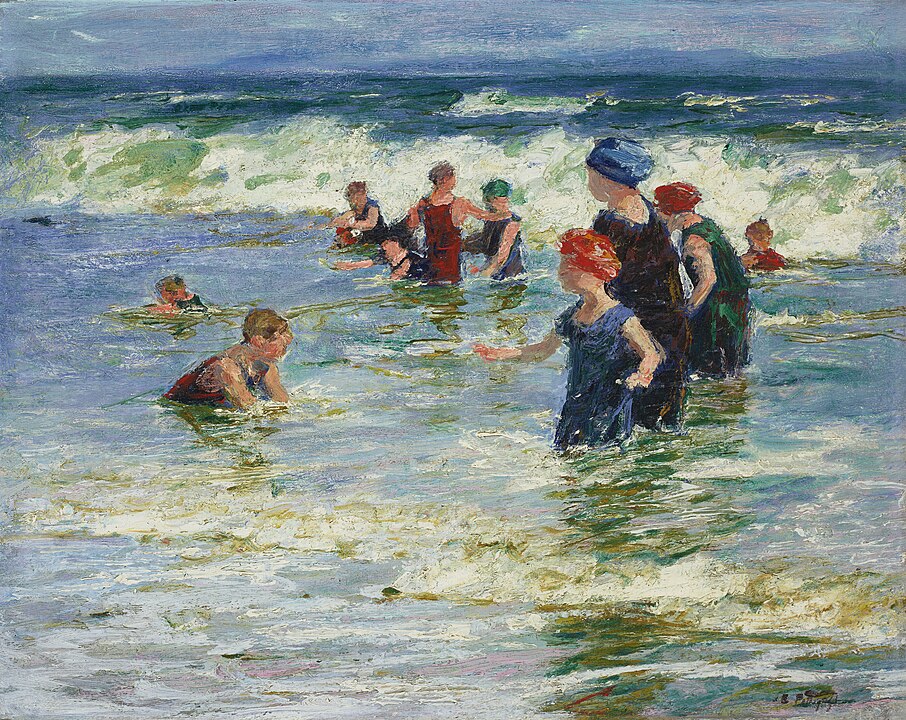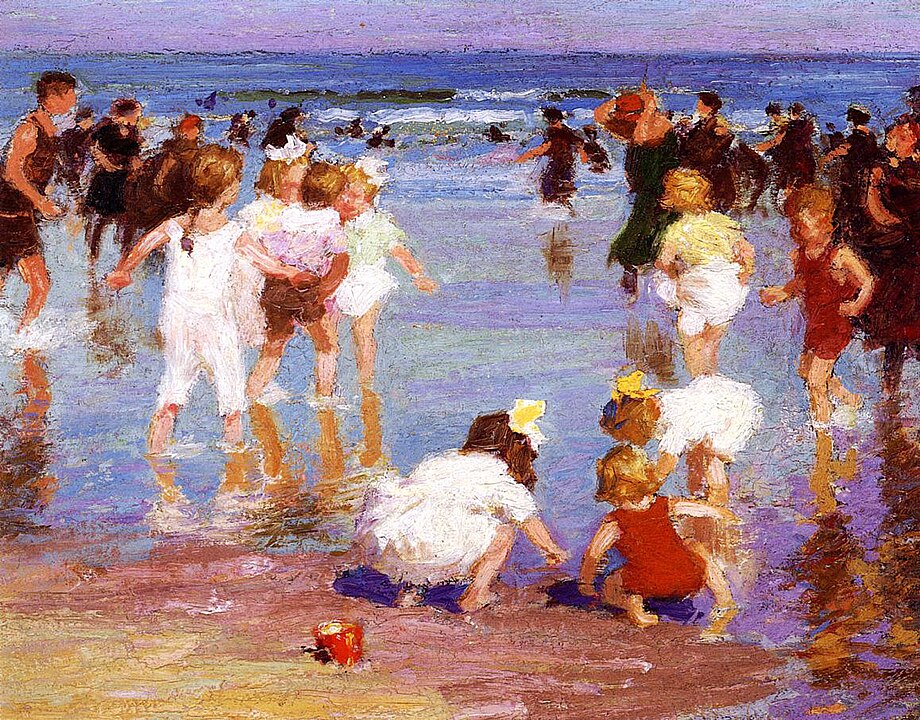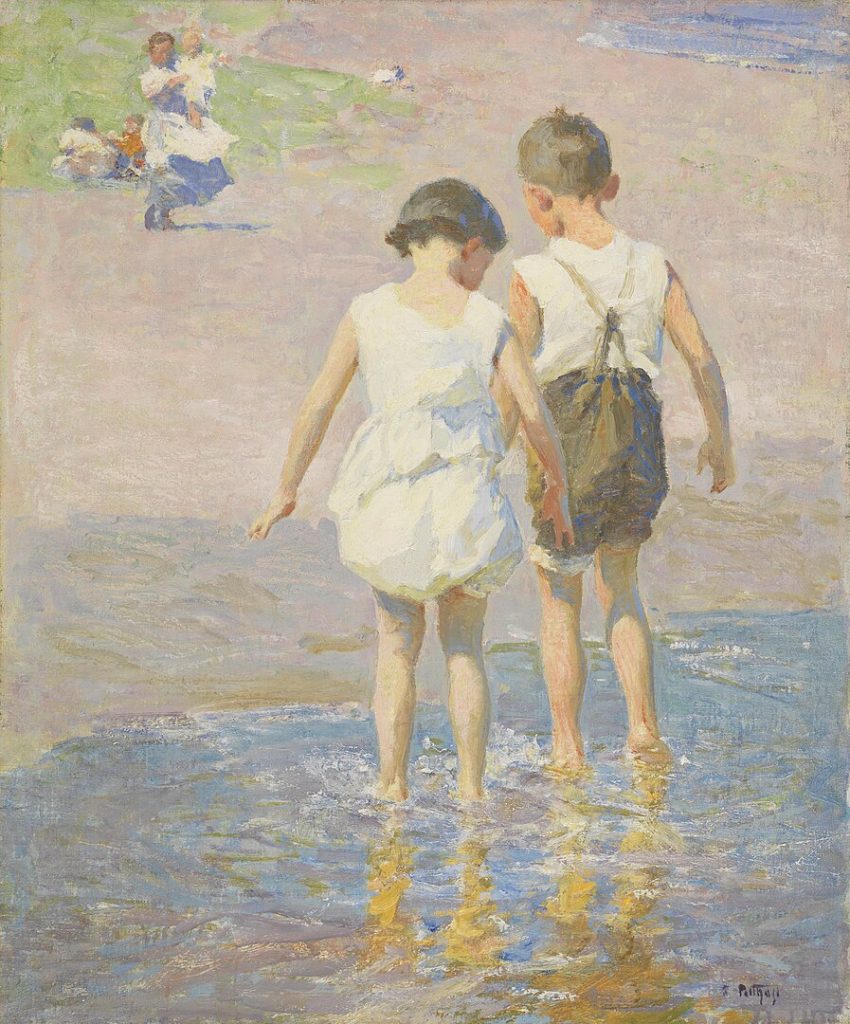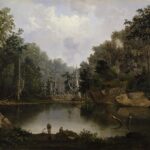
Edward Henry Potthast was a celebrated American Impressionist painter known for his luminous beach scenes and depictions of everyday life. Born in the 19th century, he emerged as a significant figure in American art, capturing the energy and optimism of the early 20th century. His work is often associated with bright colors, loose brushstrokes, and an ability to convey the joy of leisure, particularly in seaside settings. Potthast’s paintings reflect an era of growing prosperity and relaxation, immortalizing moments of middle-class pleasure.
His importance in art history stems from his ability to merge European Impressionist techniques with distinctly American themes. While many Impressionist painters focused on landscapes or aristocratic leisure, Potthast chose to depict ordinary people enjoying summer outings. His work stands out for its warm, sunlit compositions, portraying figures immersed in playful activities. Unlike his European counterparts, Potthast emphasized the accessibility and vibrancy of American public life.
This article explores the life, influences, and artistic legacy of Edward Henry Potthast. From his early years in Cincinnati to his artistic development in Europe and eventual success in New York, his journey reflects a lifelong dedication to his craft. By examining his career, signature techniques, and long-term impact, we gain insight into why his work remains beloved today. His paintings not only document a specific moment in history but also continue to evoke a timeless sense of joy and nostalgia.
Potthast’s ability to capture light and movement sets him apart in American Impressionism. His paintings transport viewers to sunlit beaches where children splash in the waves, mothers watch over their families, and the golden hues of the sand create a dreamlike atmosphere. His work remains a testament to the simple pleasures of life, inviting us to step into a world of carefree beauty and warmth.
Early Life and Artistic Beginnings
Edward Henry Potthast was born on June 10, 1857, in Cincinnati, Ohio, a city with a growing artistic community in the mid-19th century. Raised in a German-American family, he developed an early appreciation for art and craftsmanship. His first exposure to formal artistic training came when he enrolled at the McMicken School of Design, where he studied under Thomas Satterwhite Noble, a painter known for his historical and genre scenes. Under Noble’s mentorship, Potthast gained a strong foundation in academic painting techniques and composition.
During the 1870s, Potthast began working as a lithographer, a common profession for young artists at the time. Lithography allowed him to refine his skills in rendering detail and tonal variations, which would later influence his painting style. Despite working in commercial art, he remained committed to painting and continued his studies at the Cincinnati Art Academy. Here, he further developed his ability to capture light and form, setting the stage for his later artistic breakthroughs.

Cincinnati in the late 19th century was a cultural hub, fostering artistic exchange between American and European influences. Potthast was exposed to visiting exhibitions featuring European masters, which deepened his curiosity about the broader art world. His growing interest in Impressionism and tonal painting styles led him to seek further training abroad. Like many ambitious American artists of his time, he recognized the importance of studying in Europe to refine his technique and expand his artistic horizons.
By the early 1880s, Potthast had established himself as a serious artist in Cincinnati. However, he yearned for greater artistic growth and sought inspiration beyond his hometown. Encouraged by his mentors and peers, he made the pivotal decision to travel to Europe, where he would be exposed to groundbreaking artistic movements. This period of exploration would significantly shape his artistic voice, ultimately transforming his approach to painting.
European Influence and Artistic Growth
Potthast’s journey to Europe in the 1880s marked a turning point in his artistic development. He traveled to Germany, enrolling in the prestigious Royal Academy of Fine Arts in Munich, where he studied under Nikolaus Gysis. The Munich School emphasized strong contrasts, realistic detail, and dramatic lighting, all of which initially shaped Potthast’s early work. However, his exposure to different artistic styles during this period planted the seeds for a later transition toward Impressionism.
After completing his studies in Munich, Potthast traveled to France, a hotbed of artistic innovation during the late 19th century. He spent time in Paris, where he encountered the works of Claude Monet, Pierre-Auguste Renoir, and Edgar Degas. The vibrant colors, loose brushwork, and focus on everyday life in Impressionist paintings resonated deeply with him. Although he initially adhered to the darker, more academic tones of his Munich training, he gradually began experimenting with lighter palettes and more spontaneous brushstrokes.

While in France, Potthast also visited the Barbizon School, a group of painters dedicated to naturalistic landscapes. Their influence reinforced his appreciation for painting en plein air (outdoors), a practice that would become essential to his later beach scenes. During this period, he exhibited his works in Parisian salons, gaining recognition for his technical skill and growing interest in Impressionist aesthetics. This exposure helped him transition from a traditional academic painter to one embracing a more modern, light-filled approach.
By the time he returned to the United States in 1895, Potthast had fully absorbed the principles of Impressionism. Though he still retained elements of realism, his colors had become brighter, his brushwork looser, and his compositions more dynamic. Armed with a fresh artistic vision, he was ready to make his mark on the American art scene. His European experience had not only refined his technical skills but also broadened his perspective on how art could capture life’s fleeting moments.
Career in New York and Shift to Impressionism
After returning to the United States, Potthast settled in New York City, a thriving cultural hub where he could fully pursue his artistic ambitions. The city’s bustling energy, diverse artistic community, and growing appreciation for Impressionism provided an ideal environment for his work. In 1896, he secured a studio space in the famous Lincoln Arcade Building, where he dedicated himself to painting full-time. This move marked his official transition from lithography to a professional career as a painter.
During his early years in New York, Potthast became closely associated with the American Impressionist movement. He exhibited regularly at the National Academy of Design, the Society of American Artists, and the Art Institute of Chicago. His work, characterized by luminous color and spontaneous brushwork, began attracting critical attention. He was particularly drawn to the work of William Merritt Chase, a leading American Impressionist known for his depictions of leisure and urban life.
Potthast’s signature style fully emerged in the late 1890s and early 1900s, when he began focusing on beach scenes. Inspired by the coastal beauty of Long Island, New Jersey, and Massachusetts, he captured families, children, and sunbathers enjoying the seaside. His paintings radiated warmth, emphasizing the joy of outdoor leisure. Unlike earlier American painters who depicted landscapes as grand and untamed, Potthast portrayed nature as inviting and harmonious with human presence.
By the early 20th century, Potthast had become one of the most recognized painters of American Impressionism. His work was in high demand, and he continued to refine his ability to capture light, movement, and atmosphere. His contributions helped shape a uniquely American interpretation of Impressionism, blending European influences with the optimism and dynamism of the Gilded Age. His beach scenes, in particular, became iconic representations of carefree summer enjoyment.
Beach Scenes and American Identity in Art
Edward Henry Potthast’s most famous works are his luminous beach scenes, which capture the carefree joy of seaside leisure. These paintings, created primarily in the early 1900s, feature families, children, and sunbathers enjoying the sand and surf. Potthast was fascinated by the way sunlight reflected off the water, the movement of figures in the waves, and the vibrant colors of summer attire. His paintings often depict figures wading in shallow water, children digging in the sand, or groups of people relaxing under brightly colored umbrellas.
What made Potthast’s beach scenes unique was their celebration of American middle-class leisure. Unlike European Impressionists, who often painted aristocrats or idyllic countryside scenes, Potthast focused on everyday Americans enjoying public beaches. These depictions aligned with the social and economic changes of the Gilded Age and early 20th century, when more Americans had access to leisure time. His paintings reflect a society embracing outdoor recreation, a growing fascination with nature, and an appreciation for simple pleasures.
Technically, Potthast’s beach scenes demonstrate his mastery of color and light. He used warm yellows, soft blues, and delicate pinks to create a sense of vibrancy and movement. His brushstrokes, though loose and impressionistic, captured subtle details such as shimmering reflections on the water and the texture of wet sand. Unlike his earlier Munich-trained works, which had darker tones, his Impressionist beach paintings featured bright, sunlit atmospheres that exuded warmth and happiness.
Many of Potthast’s most celebrated beach paintings, such as A Holiday and Children on the Beach, are now housed in major American museums. His ability to depict fleeting moments of joy made his work widely appealing both during his lifetime and after. By focusing on the American experience of leisure, he created images that remain timeless, offering a glimpse into a world where the stresses of daily life momentarily fade in the golden glow of summer.
Later Years, Legacy, and Impact on American Art
Despite achieving significant recognition, Edward Henry Potthast remained modest and dedicated to his craft throughout his later years. He continued painting prolifically into the 1920s, regularly exhibiting his work in New York and other major American cities. While he experimented with different subjects, his focus remained on sunlit landscapes and scenes of outdoor leisure. His paintings remained popular with collectors, and he maintained a steady clientele who admired his light-filled, optimistic compositions.
As Potthast aged, he faced declining health, though he remained committed to painting until his final days. In 1927, he passed away at the age of 70 in New York City. His death marked the end of an era, as American Impressionism was gradually being overshadowed by the rise of modernism and abstract movements. However, his work remained in demand, and his paintings continued to be exhibited posthumously. His contribution to American art was widely recognized, ensuring his place in history.
Potthast’s influence extended beyond his own paintings; he helped shape the American Impressionist movement and inspired future generations of artists. His ability to blend European Impressionist techniques with distinctly American subject matter set a precedent for later artists. Many Impressionist painters who followed in his footsteps continued his tradition of capturing the beauty of everyday life, particularly in outdoor settings. His work remains a bridge between 19th-century realism and 20th-century modernism.
Today, Potthast’s paintings are featured in prestigious collections, including those at the Metropolitan Museum of Art, the Cincinnati Art Museum, and the Art Institute of Chicago. His legacy endures not only through his breathtaking beach scenes but also through his influence on American art history. His work continues to be celebrated for its timeless ability to evoke happiness, nostalgia, and appreciation for life’s simple joys.
Conclusion: The Timeless Appeal of Potthast’s Work
Edward Henry Potthast’s paintings offer a window into a world of sunshine, laughter, and carefree moments. His ability to capture the beauty of ordinary life, particularly at the beach, has ensured his place as one of America’s most beloved Impressionists. Though he never sought widespread fame, his work continues to captivate audiences with its masterful use of color and light. His paintings remind us of the joy found in nature, family, and relaxation.
Potthast’s contribution to art goes beyond his technical skill—his work reflects a cultural shift in American society. During a time of industrialization and urban expansion, his paintings offered an escape to a world of tranquility and leisure. His ability to depict these scenes with warmth and sincerity has given his paintings a lasting appeal. They remain as relevant today as they were a century ago, resonating with viewers who long for the simple pleasures of summer days.
His influence on American Impressionism continues to be studied and appreciated. By incorporating European Impressionist techniques into American themes, he helped define a uniquely American artistic identity. His work bridges the gap between tradition and modernity, offering insight into the evolution of art in the United States. His mastery of light and movement ensures that his paintings remain among the finest examples of Impressionist art.
As we look at Potthast’s vibrant beach scenes, we are reminded of the power of art to transport us to another time and place. His paintings, filled with energy and warmth, continue to inspire and uplift viewers. Whether displayed in a museum or cherished in a private collection, his work stands as a testament to the enduring magic of Impressionism and the timeless beauty of American leisure.
Key Takeaways
- Edward Henry Potthast (1857–1927) was a leading American Impressionist known for his luminous beach scenes.
- He studied in Munich and Paris, where he was influenced by both academic realism and Impressionism.
- His paintings depicted middle-class leisure, celebrating the joy of outdoor life in America.
- Potthast’s work remains in major museums, including the Metropolitan Museum of Art and the Cincinnati Art Museum.
- His legacy continues to shape American Impressionism, inspiring artists and collectors alike.
FAQs
1. What was Edward Henry Potthast known for?
Potthast was best known for his vibrant beach scenes, which depicted people enjoying seaside leisure in the early 20th century.
2. Where did Edward Henry Potthast study art?
He studied at the McMicken School of Design in Cincinnati, the Royal Academy of Fine Arts in Munich, and also spent time in Paris.
3. What artistic style did Potthast use?
He was an American Impressionist, blending Impressionist techniques with a focus on American subjects, especially outdoor leisure.
4. Why are Potthast’s paintings significant?
His work captured the spirit of American leisure during the Gilded Age, using color and light to evoke happiness and nostalgia.
5. Where can I see Potthast’s paintings today?
His work is featured in major collections, including the Metropolitan Museum of Art, Art Institute of Chicago, and Cincinnati Art Museum.
Edward Henry PotthasT CHEATSHEET
Born: June 10, 1857
Died: March 9, 1927
Nationality: American
Hometown: Cincinnati, Ohio, USA
Artistic Profile
Movement: American Impressionism
Primary Medium: Oil Painting
Notable Works:
- A Holiday
- Children on the Beach
- The Seashore
- Sunlight and Shadow
- Afternoon Fun
Influences:
- French Impressionists (Claude Monet, Pierre-Auguste Renoir, Edgar Degas)
- The Munich School (Nikolaus Gysis, Carl von Marr)
- American Impressionists (William Merritt Chase)
Style & Technique:
Potthast’s style is characterized by loose brushwork, vibrant color palettes, and a focus on natural light and movement. His paintings often depict sunlit outdoor scenes, particularly beach outings, with an emphasis on middle-class leisure. He mastered the play of sunlight reflecting off water, sand, and human figures, capturing a sense of warmth and fleeting moments of joy.
Career Highlights
Active Years: 1880s–1927
Education:
- McMicken School of Design, Cincinnati
- Royal Academy of Fine Arts, Munich
Major Exhibitions:
- National Academy of Design, New York
- Society of American Artists Exhibitions
- Art Institute of Chicago
- Pennsylvania Academy of the Fine Arts
- Cincinnati Art Museum
Awards & Honors:
- Silver Medal, Pan-American Exposition (1901)
- Gold Medal, Philadelphia Art Club (1910)
- Various honors from the National Academy of Design
Patrons or Supporters:
- Wealthy collectors of the Gilded Age
- Prominent American galleries and institutions
Beyond Art
Cultural Impact:
Potthast’s work contributed to the American perception of leisure and outdoor life, shaping how Americans viewed Impressionist themes. His beach scenes encapsulated the joy of the progressive era’s middle-class lifestyle, reinforcing the idea that art should depict real, everyday experiences.
Collectors & Value:
His paintings are highly sought after, with many owned by major museums and private collectors. Potthast’s works typically sell for hundreds of thousands of dollars, with some exceeding $1 million at auctions.
Mysteries & Lost Works:
While there are no widely known lost or stolen works, several of his paintings remain in private collections, rarely seen by the public.
Lesser-Known Facts:
- He was originally trained as a lithographer, working in commercial art before fully pursuing painting.
- Unlike many of his peers, he never married and was entirely dedicated to his art.
- His beach paintings were likely inspired by Coney Island, Long Island, and New England coastal towns.
Pop Culture Connections:
- His paintings have been referenced in art books and American Impressionist retrospectives.
- His work appears in documentaries on American Impressionism, but he remains lesser-known in mainstream media compared to Monet or Renoir.
Homes & Studios:
- Lived in New York City from 1895 until his death.
- Maintained a studio in the Lincoln Arcade Building, New York, where he painted many of his famous works.
Restoration & Preservation:
His paintings are well-preserved in major museum collections, undergoing regular cleaning and restoration to maintain their vibrant colors and textures.
Personal Life & Relationships
Parents: Henry and Bernadine Potthast
Siblings: Limited historical records on siblings
Spouse/Partner: Never married
Children: None
Notable Friendships:
- Associated with William Merritt Chase and other American Impressionists
- Maintained connections with fellow Cincinnati artists and New York painters
Romantic Affairs: No documented relationships; Potthast was known for being private and dedicated to his work.
Additional Info
Controversial or Banned Works: None known; his paintings were widely accepted and celebrated.
Most Expensive Sale:
- A Holiday sold for over $1 million at auction.
Where to See Their Work:
- Metropolitan Museum of Art (New York City)
- Art Institute of Chicago
- Cincinnati Art Museum
- Brooklyn Museum
- Smithsonian American Art Museum
Connection to Fashion & Design:
His paintings often depict turn-of-the-century beachwear, capturing an era of evolving fashion and social customs in America. His bright colors and fluid brushstrokes influenced textile and interior design trends in the early 20th century.
Influence on Movies, TV, and Music Videos:
While his work is not widely referenced in pop culture, his Impressionist style has inspired cinematographers and filmmakers depicting early 20th-century leisure scenes.
Famous Quotes:
- “No day is too long or too bright when spent with a brush in hand.” (Attributed but unverified quote, sooo… take with a grain of salt.)
Signature Colors or Techniques:
- Warm yellows, soft blues, and pastel pinks to capture sunlight and atmosphere.
- Loose, spontaneous brushstrokes to emphasize movement and energy.
Art Hoaxes & Forgeries:
- Some misattributed works have surfaced at auction, though forgeries are not as common compared to more famous Impressionists.
Destroyed or Lost Artworks:
- Some of his early Munich School paintings may have been lost or destroyed over time, as his pre-Impressionist works are rarer.
The Artist’s Signature & Identification:
- Potthast often signed his works in the lower right-hand corner, sometimes in a subtle, cursive style.
- His paintings are recognizable by their sunlit beach compositions, energetic figures, and shimmering water reflections.




